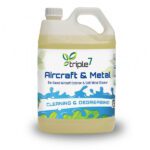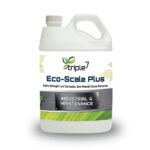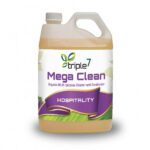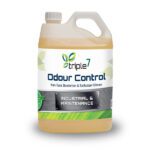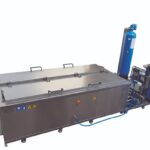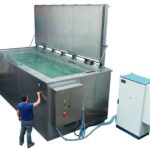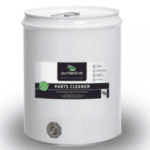Table of Contents
Introduction
In the world of industrial manufacturing, keeping your equipment and parts clean is not just a matter of good maintenance—it’s essential for ensuring they run smoothly and last as long as possible. But when it comes to cleaning, one size doesn’t fit all. While water-based cleaners might be your go-to for many situations, they can sometimes cause more harm than good, especially with parts that are delicate or prone to corrosion. This is where ultrasonic cleaning steps in, offering an alternative that’s both effective and gentle on sensitive components.
Ultrasonic cleaners are known for their ability to clean thoroughly without being invasive. They can reach the tiniest nooks and crannies, dislodging dirt and grime that other methods might miss. But before diving in and choosing an ultrasonic cleaner for your industrial parts, it’s important to ask the right questions. This guide is here to help you navigate those questions, so you can make a decision that balances safety, efficiency, and effectiveness.
Understanding Ultrasonic Cleaning for Industrial Parts
So, what exactly is ultrasonic cleaning? At its core, it involves using high-frequency sound waves to create tiny, powerful bubbles in a cleaning solution. When these bubbles implode, they produce a cleaning action strong enough to remove dirt, grease, and other contaminants from even the most hard-to-reach areas of your parts.
Ultrasonic cleaning shines in industrial applications, particularly when dealing with parts that have complex shapes, fragile components, or materials that can’t handle the harshness of traditional cleaning methods. Industries like aerospace, automotive, electronics, and medical device manufacturing often rely on ultrasonic cleaning to ensure their parts are as clean as possible without causing damage.
Why Water-Based Cleaners Might Not Be the Best Choice
Water-based cleaners are popular for good reasons—they’re effective, easy to use, and often environmentally friendly. But they’re not always the best option, especially for certain industrial parts. Here are a few reasons why:
- Corrosion Risks: Metals like aluminum and magnesium can corrode when exposed to water, especially if they aren’t dried properly after cleaning. This can lead to surface damage and a shorter lifespan for your parts.
- Material Degradation: Some materials, like certain polymers or composites, might swell, soften, or degrade when exposed to water-based cleaners, which can affect their performance.
- Incomplete Cleaning: Water-based solutions might not be able to fully remove certain contaminants, like oils or greases, especially from parts with complex geometries.
- Residue Issues: Sometimes, water-based cleaners leave behind residues that can interfere with processes like painting, coating, or assembly.
Given these potential downsides, it’s worth considering alternatives like ultrasonic cleaning for parts that are sensitive to water.
Questions to Ask Before Choosing an Ultrasonic Cleaner
Picking the right ultrasonic cleaner isn’t just about finding the first one that seems suitable—you’ll want to consider several key factors. Here are some questions to guide you:
What Exactly Do You Need to Clean?
Before you start shopping for an ultrasonic cleaner, think about what you’re trying to achieve. What contaminants are on the parts? Are they mostly oils, metal shavings, or something else? What level of cleanliness is required? Are there industry standards you need to meet? Understanding these details will help you choose the right cleaning process and settings.
Is the Material Compatible with Ultrasonic Cleaning?
Not all materials are a good fit for ultrasonic cleaning. Some might be too delicate, while others could react badly to the cleaning process. Make sure the material of your parts can handle the cleaning solution and the heat generated by the process without degrading or getting damaged.
What Frequency and Power Levels Will You Need?
The effectiveness of ultrasonic cleaning largely depends on the frequency and power levels of the cleaner. Lower frequencies are more aggressive and better for heavy-duty cleaning, while higher frequencies are gentler and better for delicate parts. You’ll also need to consider the power levels—too much power can damage sensitive materials, but too little might not clean effectively.
The Benefits of Ultrasonication for Sensitive Parts
Ultrasonication, or the use of ultrasonic waves for cleaning, offers several advantages, especially for sensitive and complex parts:
- Thorough Cleaning: Ultrasonication can reach into even the smallest crevices, ensuring that every part is completely clean.
- Non-Abrasive: Unlike mechanical cleaning methods, ultrasonication doesn’t scratch or damage delicate surfaces.
- Reduced Manual Labor: Ultrasonic cleaning is mostly automated, so it reduces the need for manual scrubbing or disassembly.
- Consistency: The process is consistent and repeatable, ensuring that each part meets the required cleanliness standards.
- Eco-Friendly Options: You can choose environmentally friendly solvents, reducing the impact on the environment compared to harsher chemicals.
The Role of Automation in Ultrasonic Cleaning
Automation is becoming more and more important in industrial cleaning processes, and ultrasonic cleaning is no exception. Automated systems can greatly enhance the efficiency, safety, and consistency of your cleaning process. Here’s how:
- Efficiency: Automated systems can clean multiple parts at once, reducing cycle times and increasing throughput.
- Consistency: Automation ensures that each part is cleaned exactly according to pre-set parameters, reducing the risk of human error.
- Workflow Integration: Automated ultrasonic cleaners can be seamlessly integrated into production lines, reducing downtime and streamlining your workflow.
Safety Considerations for Ultrasonic Cleaning
While ultrasonic cleaning is generally safe, it’s important to follow certain safety protocols to protect workers and ensure the cleaning process is effective:
- Chemical Handling: Make sure all cleaning solvents are handled and stored safely, and provide appropriate protective equipment for workers.
- Ventilation: Ultrasonic cleaning can produce fumes, especially with certain solvents. Proper ventilation is essential to keep the work environment safe.
- Monitoring: Regularly check the temperature and power levels of the ultrasonic cleaner to prevent overheating or excessive power, which could damage parts or pose safety risks.
Case Study: A Success Story with Ultrasonic Cleaning
To illustrate the benefits of ultrasonic cleaning, let’s look at a real-world example. A manufacturer of precision medical devices needed to clean intricate stainless-steel components used in surgical instruments. These parts were prone to corrosion and residue when cleaned with water-based methods.
Challenges:
- The parts had complex shapes with small holes and fine threads, making them difficult to clean thoroughly with traditional methods.
- The company needed a cleaning process that wouldn’t cause corrosion or surface damage.
Solutions:
- The company chose an industrial ultrasonic cleaner with adjustable frequency settings to fine-tune the cleaning process for each type of part.
- They used a mild, non-corrosive solvent that was effective at removing organic residues without damaging the stainless steel.
- The ultrasonic cleaner was integrated with an automated system, enabling the cleaning of multiple parts simultaneously and reducing cycle times.
Outcomes:
- The ultrasonic cleaner successfully removed all contaminants from the parts, even in hard-to-reach areas, without causing any surface damage.
- The automated system increased throughput by 30%, allowing the company to meet production targets more efficiently.
- The switch to ultrasonic cleaning resulted in significant cost savings by reducing the need for manual labor and rework.
Overcoming Challenges in Ultrasonication
While ultrasonic cleaning offers many benefits, it does come with its own set of challenges. Here’s how to address them:
- Complex Geometries and Delicate Components: When dealing with intricate or fragile parts, use ultrasonic cleaners with adjustable settings and consider using custom fixtures to protect them during cleaning.
- Environmental and Safety Concerns: Choose eco-friendly solvents and implement proper ventilation and safety protocols to manage fumes and ensure worker safety.
Conclusion: Making the Best Choice for Your Cleaning Needs
Ultrasonic cleaning is a powerful and versatile solution, especially for industrial parts that can’t handle water-based cleaners. By asking the right questions and considering the specific needs of your parts, you can choose an ultrasonic cleaner that delivers effective, efficient, and safe cleaning. From understanding your cleaning requirements to evaluating the benefits of ultrasonication and the role of automation, this guide has provided the insights you need to make an informed decision.
When done right, ultrasonic cleaning can enhance the cleanliness, performance, and lifespan of your industrial parts, contributing to the overall success of your manufacturing processes.
Ready to enhance your cleaning process and protect your industrial parts? Discover the power of ultrasonic cleaning today—contact us for expert guidance and the perfect solution for your needs.
Contact Number: +917550032102
Email: info@esp-ultrasonic.in








